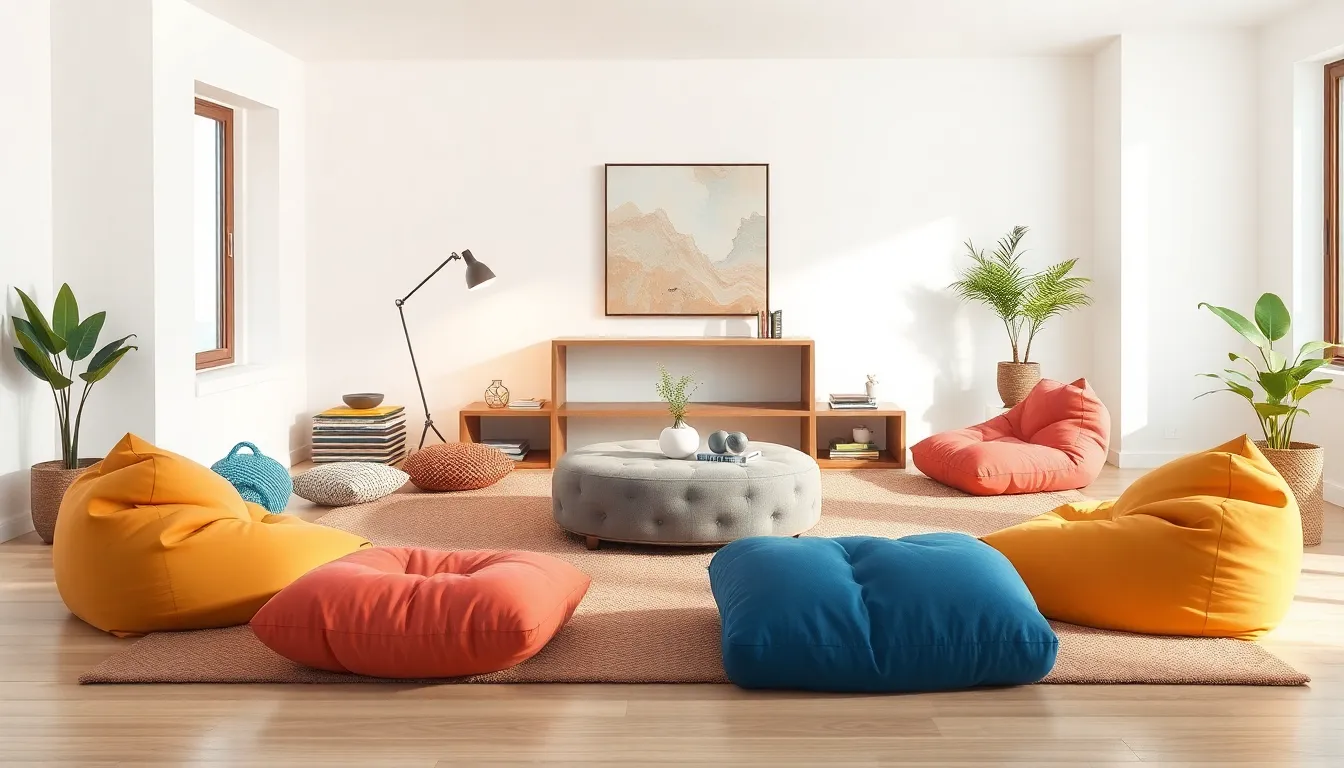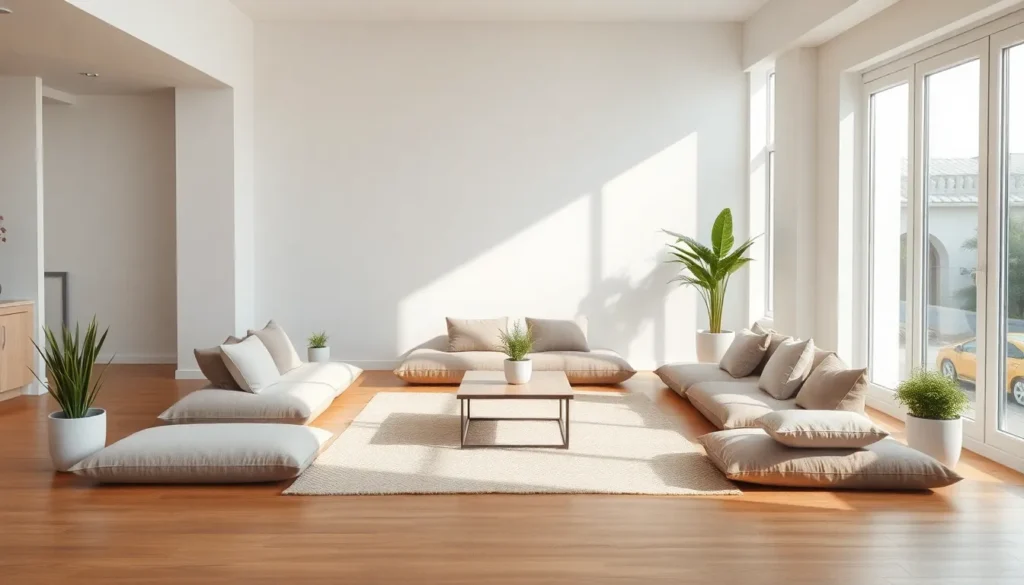Table of Contents
ToggleImagine a living room that whispers sophistication instead of shouting for attention. A minimalist space without a sofa might sound like a design faux pas, but it’s actually a bold statement in modern living. Who needs bulky furniture when you can create an airy oasis that invites creativity and conversation?
Ditching the sofa opens up a world of possibilities. Think floor cushions, chic poufs, or even a cozy hammock—because why not swing your way into relaxation? This approach not only maximizes space but also encourages a lifestyle that embraces simplicity and functionality. So, if you’re ready to redefine comfort and style, let’s explore how to craft a stunning minimalist living room that leaves the sofa in the dust.
Understanding Minimalist Living Room Design
Minimalist living room design emphasizes simplicity and functionality. A focused approach creates a serene environment that fosters connection and creativity.
Key Principles of Minimalism
Emphasizing clean lines and open spaces defines minimalist design. Simplifying elements leads to less visual clutter and more room for personal expression. Prioritizing a neutral color palette enhances calmness and cohesion in the living area. Selecting multifunctional furniture supports practical use while maintaining aesthetic appeal. Arranging decor with intention allows for meaningful accents without overwhelming the space. Understanding these principles paves the way for a sophisticated, understated living room.
Benefits of a Sofa-Free Space
Creating a sofa-free space opens up the room, allowing for fluid movement and interaction. Utilizing floor cushions promotes a relaxed atmosphere, inviting guests to gather and converse comfortably. Embracing versatility with poufs or hammocks provides varied seating options tailored to different activities. Prioritizing functionality often leads to easier cleaning and maintenance, contributing to an overall sense of calm. Increasing natural light through open spaces enhances the ambiance, making the living room feel airy and welcoming.
Alternative Seating Solutions

Creating a minimalist living room without a sofa opens up various seating options that maintain comfort and style. Unique solutions enhance the space’s functionality while aligning with minimalist principles.
Floor Cushions and Bean Bags
Floor cushions provide versatile seating while adding a cozy touch. Arranging multiple cushions can accommodate guests and encourage a laid-back atmosphere. Bean bags offer a playful option, seamlessly fitting into a minimalist design. They are lightweight and easy to move, allowing for adaptable seating arrangements that suit different occasions. Selecting cushions or bean bags in neutral or muted tones enhances serenity, encouraging a cohesive look that complements the living room’s overall aesthetic.
Ottomans and Poufs
Ottomans serve dual purposes, acting as both seats and functional surfaces for drinks or decor. Choosing ottomans with storage capabilities maximizes space efficiency, keeping the area clutter-free. Poufs, available in various materials and textures, can introduce visual interest while remaining lightweight and easy to reposition. Many poufs work well for informal gatherings, inviting relaxation and conversation. These options offer flexibility in seating configurations, supporting a fluid minimalist environment that promotes an open, airy feel.
Decorating Techniques for a Minimalist Look
Creating a minimalist living room without a sofa involves thoughtful design choices. Focus on techniques that promote simplicity yet provide comfort and functionality.
Choosing the Right Color Palette
A neutral color palette enhances the serene atmosphere of a minimalist space. Soft whites, grays, and earthy tones create an inviting backdrop. Incorporating one or two accent colors adds visual interest without overwhelming the room. Shades of blue or green, for example, bring a calming effect. Using varying tones of the same color maintains cohesion while avoiding clutter. It’s essential to balance between light and dark hues to prevent a flat appearance, ensuring the room feels dynamic.
Incorporating Natural Elements
Natural elements foster a sense of peace and connection to the outdoors. Incorporating wooden furniture or accessories introduces warmth, making the space feel cozy. Plants also play a vital role; they add life and enhance air quality. Consider large leafy plants for a bold statement or small succulents for subtle accents. Using textiles made of natural fibers, like cotton or linen, contributes to a tactile appeal. Natural light is equally important; maximizing window space invites warmth into the room, further emphasizing a minimalist aesthetic.
Essential Furniture Pieces
Creating a minimalist living room without a sofa relies on choosing essential furniture pieces that promote comfort and functionality. Prioritizing simplicity, these items enhance the overall aesthetic while maintaining a serene atmosphere.
Multi-Functional Furniture
Multi-functional furniture stands as a cornerstone in minimalist design. Consider using a coffee table that doubles as storage, keeping clutter at bay. Ottomans can serve as both extra seating and a place to rest drinks. Incorporate foldable chairs that store easily when not in use, ensuring maximum space efficiency. A bench can act as seating and a decorative element. These versatile pieces allow for flexibility while aligning with minimalist principles.
Minimalist Coffee Tables and Side Tables
Minimalist coffee tables and side tables play a crucial role in simplifying the living space. Look for tables with clean lines and minimal ornamentation. Glass or lightweight wood options create openness while maintaining functionality. A nesting table set offers adaptability, allowing for varying arrangements as needs change. Choose tables with a neutral color palette to enhance calmness. Incorporating these tables fosters a sense of balance and peace within a sofa-free living room.
Tips for Creating a Cozy Atmosphere
Creating a cozy atmosphere in a minimalist living room without a sofa involves thoughtful choices in lighting and decor.
Lighting and Accessories
Natural light remains essential for fostering warmth. Use sheer curtains to invite sunshine while maintaining privacy. Layered lighting enhances comfort; floor lamps and table lamps provide versatility. Accent lighting, such as LED strips, can highlight architectural features or add ambiance. Accessories, like textured throws or soft rugs, contribute inviting touches. Incorporating natural elements, like wooden decor, creates a calming effect. Minimalist candle holders, with simple designs, offer soft illumination in the evenings.
Artwork and Decorative Items
Artwork plays a crucial role in personalizing a minimalist space. Select pieces that resonate with individual style, ensuring they complement the room’s neutral palette. Hang large-scale artwork to create a focal point without crowding the walls. Decorative items should maintain harmony; choose only a few carefully curated pieces. Plants add life and color, fitting seamlessly into a minimalist theme. Additionally, handmade pottery or sculpture can provide unique character. Prioritize functionality when choosing decorative items, ensuring they serve a purpose while enhancing visual appeal.
Embracing a minimalist living room without a sofa opens up a world of possibilities for creating a serene and inviting space. By opting for alternative seating solutions like floor cushions and poufs, individuals can enhance fluidity and comfort while maintaining a stylish aesthetic.
Thoughtful design choices such as a neutral color palette and multifunctional furniture further amplify the minimalist approach, allowing for personal expression without overwhelming clutter. Incorporating natural elements and layered lighting adds warmth and character, making the space feel both cozy and functional.
Ultimately, a sofa-free living room not only promotes a simpler lifestyle but also fosters creativity and connection, proving that less truly can be more.




